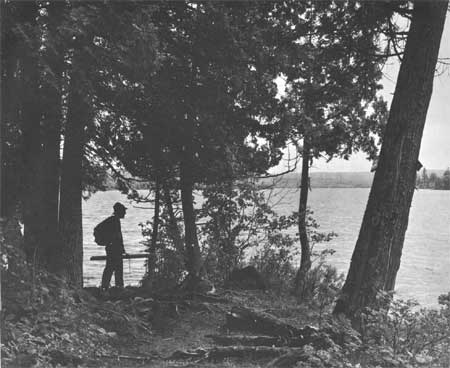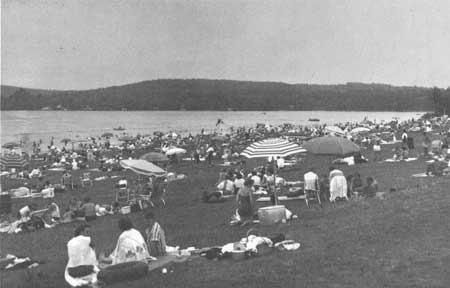.gif)
Parks for America
MENU
|
Parks for America
|

|
PLANNING ELEMENTS
INTRODUCTION
Park and recreation planning is not an exact science. It deals with many intangibles, with Nature and the elements of Nature which, depending on the individual, are the source of or provide background for personal satisfactions. It deals with the selection and protection of areas where the natural features have certain qualities that appeal to man—that inspire, stimulate, and refresh. It also deals with the determination of the amount, kind, and location of areas required to provide these opportunities for enjoyment, now and in the foreseeable future.
CLASSIFICATION OF AREAS
The term "park" is frequently used generically and applied to many different kinds of areas. Most of the States use a number of classifications based upon considerations such as character, use, custom, and statutory requirements. These vary from State to State, and more than 60 classifications are currently in use. And there are extensive public areas reserved for purposes other than recreation which also offer recreation opportunities in addition to the use for which they were primarily intended.
NATIONAL
Established areas administered by agencies of the Federal Government, and potential areas of national significance, have been classified in accordance with the following definitions:
National Parks.—Spacious land areas essentially of primitive or wilderness character which contain scenery and natural wonders so outstanding in quality that their preservation intact has been provided for by their having been designated and set aside by the Federal Government to be preserved unimpaired for the benefit, enjoyment, and inspiration of the people.
National Monuments.—Nationally significant landmarks, structures, objects, or areas of scientific or prehistoric interest so designated by the Federal Government for preservation and public use.
National Recreation Areas.—Spacious areas selected, developed, managed, and conserved to provide broad public recreation opportunities which can best be provided by the Federal Government or where there is a Federal responsibility to conserve and develop recreation opportunities.
National Seashores.—Natural coastal areas set aside for the preservation and public recreation use of their nationally significant scenic, scientific, historic, or recreation values, or a combination of such values. (The term "national lakeshores" has been used recently to designate similar types of proposed areas on the Great Lakes, and "national rivers" has been suggested in proposals to preserve free-flowing streams.)
National Parkways.—Federally owned elongated parks featuring roads designated for pleasure travel, and embracing scenic, recreational, or historic features of national significance. Access from adjoining properties is limited and commercial traffic is not permitted. National parkways have sufficient merit and character to make them a national attraction and not merely a means of travel from one region to another. National parkways can be established only by acts of Congress.
National Historic Sites.—Historic sites, buildings, or objects so designated in recognition of their national significance.
National Memorials.—Structures or areas designated to commemorate ideas, events, or personages of national significance.
National Battlefields.—Battlefields of national significance preserved in part, or in entirety, for the inspiration and benefit of the people.
National Wildlife Refuges.—Areas administered by the Bureau of Sport Fisheries and Wildlife, designated for the protection and propagation of game animals, birds, and fish, within which certain outdoor recreation facilities and activities are permitted as long as they do not interfere with the primary purposes of the refuges.
National Forests.—Federal lands administered by the Forest Service, U.S. Department of Agriculture, under a multiple-use policy for outdoor recreation, range, timber, watershed, and wildlife and fish purposes.
STATE AND LOCAL
In formulating the recommendations set forth in this plan, established and potential State, local, quasi-public, and private areas have been classified in accordance with the definitions that follow. These were based on definitions adopted by the Board of Directors of the National Conference on State Parks.
Parks.—Relatively spacious areas of outstanding scenic or wilderness character, oftentimes containing also significant historical, archeological, ecological, geological, and other scientific values, preserved as nearly as possible in their original or natural condition and providing opportunity for appropriate types of recreation where such will not destroy or impair the features and values to be preserved. Commercial exploitation of resources is usually prohibited.
Monuments and Historic Sites.—Areas, usually limited in size, established primarily to preserve objects of historic and scientific interest, and places commemorating important persons or historic events. The facilities usually provided are those required for the safety and comfort of the visiting public, such as access, parking, water sanitation, interpretive devices, and some times facilities for picnicking and other recreation facilities.
Recreation Areas.—Areas selected and developed primarily to provide nonurban outdoor recreation opportunities to meet other than purely local needs but having the best available scenic quality. Hunting and some other recreation activities not usually associated with parks may be permitted. Commercial exploitation of resources is usually prohibited. (This report suggests the acquisition of some nonurban areas to assist in meeting purely local needs.)
Waysides.—Relatively small areas along highways selected for their scenic or historical significance and providing opportunity for the traveler to relax, enjoy a scenic view, read a historical marker, or have a picnic lunch.
In addition to the preceding definitions adopted by the National Conference on State Parks, other types of areas referred to in this report are defined as follows:
Wilderness.—Areas to preserve primeval environment and de voted primarily to such wilderness types of educational and recreational uses as are consistent with the maintenance of the natural character of the area.
Nature Preserves.—Areas, often limited in size, established for the purpose of preserving distinctive natural communities of plants and animals for their scientific and esthetic interest.
Beaches.—Areas with frontage on the oceans, lakes, and streams designed primarily to provide swimming, boating, fishing, and other waterfront activities. Other coastal areas acquired primarily for the scenic and scientific values, such as Point Lobos Preserve in California, are included in the classification "parks."
Parkways.—Elongated or "ribbon" parks featuring a motor road for noncommercial traffic, connecting parks, monuments, beaches, and recreation areas or otherwise affording an opportunity for pleasant and safe driving. Access and roadside developments are controlled. As an adjunct to the motor road, appropriate facilities such as turnouts, picnic areas, and other recreation developments are frequently provided where space permits.
Scenic Roads.—Generally, rural highways, existing or proposed, located in areas having such highly scenic or cultural values that their further development for emphasis on safe and pleasant recreation motoring is justified, including facilities for interpretation of cultural features, for picnicking and camping and development of other recreation potentialities for the road side.
Trails.—Extended and usually continuous strips of land or water established independently of other routes of travel and dedicated, through ownership or easement, to recreational travel, including hiking, bicycling, horseback riding, or canoeing.
Free-Flowing Streams.—Streams or portions of streams that are still unmodified by the works of man or that, in spite of such modification, retain natural scenic qualities and recreation opportunities. There must be provision for adequate protection against undesirable streamside developments, and for the preservation through public control of the existing character and quality of the adjacent landscape.
Forests.—Areas established and managed primarily for timber production and watershed protection. Recreation is an increasingly important use.
 
|
| Wise park and recreation planning in America must protect the solitudes, as an Isle Royale National Park, Mich. (top) . . . And at the same time provide places where thousands can enjoy beach use as here at Hopatcong State Park, N.J. (bottom) |
NEXT >>>
|
|
Last Modified: Mon, Sep 6 2004 10:00:00 pm PDT
parks_america/planning.htm
 Top
Top